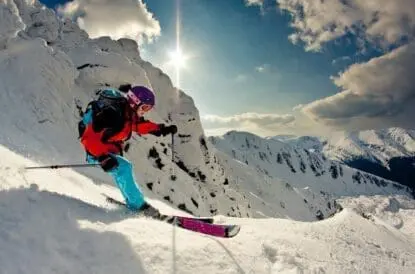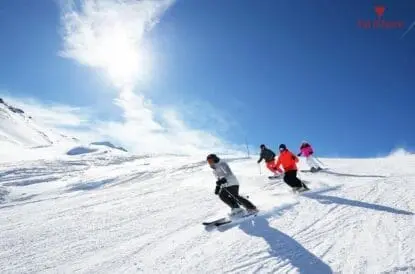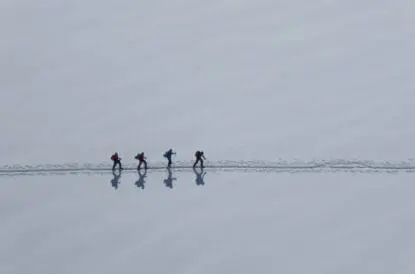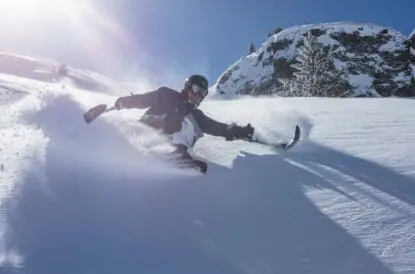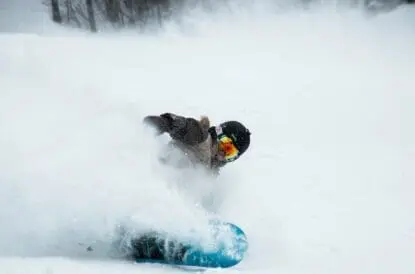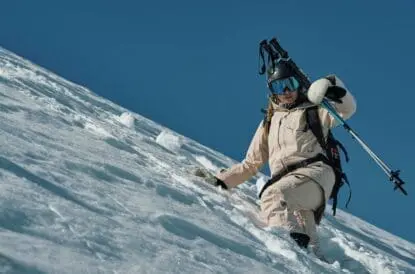With so many models and types of ski boot out there, the choice can be overwhelming. This handy guide will help you choose the right ski boots for your skiing and buy the perfect pair. Proper fit, appropriate level of stiffness, and comfort are all essential for a great day of skiing. Although the initial purchase price can be high, they last for years and provide a consistent foundation for improving your skills, as well as saving the hassle of going back and forth to the rental shop during your holiday to find something comfortable. Spending the time with a skilled ski boot fitter will pay off.
Alpine
Alpine (downhill) ski boots have a stiff plastic shell designed to hold your foot and ankle firmly in place. For the best performance, you should buy the smallest ski boot you can comfortably wear and use only one thin synthetic sock. All ski boots expand in size slightly after you have worn them several times, as the foam material in the liner is compressed. This process is known as ‘packing out’.
Plan on spending at least an hour with a skilled ski boot fitter, and try on many different ski boots. A bargain boot that doesn’t fit is no bargain. As your skill improves, you generally want a stiffer (and often more expensive) ski boot designed for faster, more precise and more aggressive skiing. If you’re a beginner or an intermediate, you don’t need this stiffness unless you’re of above-average size or weight.
If your foot is very difficult to fit or you simply want the best fit possible, inquire about custom ski boot fitting. Some manufacturers recommend special moulding systems that make either the boot liner or the ski boot shell conform exactly to your foot. All alpine ski boots are compatible with all conventional alpine ski bindings and most frame touring bindings. Alpine ski boots can be divided into 4 main categories:
Piste – boots are generally designed for comfort & regular resort skiing, then often feature ‘walk mode’ that makes it easier to plod around the streets when you are not skiing, these can add a bit of weight to the boot and in some cases can fail (giving you a floppy boot when skiing) though they have improved in recent years. Performance piste boots tend to be stiffer and more precise, taking many of the technologies of a Race boot.
Race – boots are purely focused on performance so are stiff and tight. Because of this they are often fairly uncomfortable as all day ski boots, which is why most racers unbuckle them whenever they are not bashing gates.
Freeride – boots are designed to deal with mixed terrain so often have stiff lateral flex (side to side) with a bit of forward give to absorb drops and sudden changes. The tend to be lighter than other boots and often have a grippy sole, both of these features are to help with boot packing or skinning uphill.
Freestyle – boots are built to deal with the impacts of hitting jumps and rails in the snow park so are usually fairly flexible.
Touring
Touring or AT boots are primarily differentiated from downhill boots in having a mechanism/switch on them to change from a skiing mode to a touring mode. In touring mode the cuff of the boot can move forward and backwards with a greater range of movement, allowing you a more natural stride motion when touring. Dedicated touring boots are lightweight, and have a large range of motion in the cuff making skinning uphill far more efficient. In the past, touring boots have often had the uphill advantage but with a distinct loss in downhill ability. However, boots have developed a lot in recent seasons and now there’s a wide variety of alpine boots available with a walk mode (the name for the touring mode on a ski boot) that fit frame bindings and AT boots that ski well and fit a tech binding. This means that whatever your skiing you can get a boot to match, although boots with higher downhill performance are typically heavier than the other end of the spectrum, a skimo ultra-lightweight race boot.
A touring binding will allow you to free your heel on the uphill, but secure it again for the down. The really lightweight touring boots tend to have inserts so they can be used with pin touring bindings but not all will work with step-in touring bindings, so it is essential to check boot/binding compatibility.
Different bindings exist for touring set-ups, from lightweight pin-only to full frame bindings that move with the boot away from the ski. Check out our guide on binding types to ensure your boots and binding match.
Gripwalk
Gripwalk is a new technology that offers a grippy rubber sole to ski boots, providing grip when walking through town and bootpacking out from the lift. The sole shape is also different to make walking easier.
Gripwalk boots are only compatible with Gripwalk approved bindings – as a rule of thumb, any binding manufactured later than 2020 will be Gripwalk compatible, and thus able to accept Gripwalk boots, although Gripwalk has been gradually rolled out since c.2017.
If you are buying new boots for an existing pair of bindings, double check that the bindings are Gripwalk compatible.
Cross-Country
Cross-country ski boots need to provide ankle and heel support but still allow your toes some freedom of movement. In terms of weight and support they are really more similar to hiking boots. Because you will be lifting your heel as you ski, the ski boot needs to be comfortable as you bend your foot. Check to see that the sole is laterally stiff, meaning that you can’t wring the boot like a dishrag. Plan on wearing one pair of medium-weight socks. For racing, weight matters, and lightweight boots cost more.
There are two main types of Nordic boots, Touring and Classic/Race. Touring boots are usually higher cuffed to deal with deeper snow and can be built more like a hiking boot, those designed for a metal edge ski will be stiffer and sometimes have a solid plastic cuff to transfer power to the edge. Classic/Race boots are normally lower in the cuff for a wider range of movement and are as light as possible.
If you already own cross-country skis, check that new ski boots are compatible with your current ski bindings, as there are some variations between the main standards:
NN – is the oldest standard and if you have a set of these, with the wide toe piece and 3 spikes, you are probably out of luck for new boots as the system is effectively obsolete.
NNN/NNN-BC – is the most common Nordic binding and features a metal bar across the front of the boot that slots into the binding.
SNS-Profil – is the main Salomon proprietary system and is very similar to NNN.
SNS-Pilot – is the newer Salomon system which uses two metal bars, making it easier to get in to the bindings and skate the ski. SNS pilot boots can fit onto Profil bindings but not the other way around.
Telemark
A telemark ski boot used to be just a heavy-duty cross-country ski boot. Now it looks more like a downhill ski boot, with some important differences. Telemark skiers mostly skiing lift-accessed areas will now most likely opt for a tall, stiff boot. Those who also use their telemark equipment for touring will typically choose a lighter weight set-up. As with alpine ski boots, spend time with a qualified ski boot fitter and experiment with different ski boots.
A properly fitting ski boot holds your heel firmly yet allows your toes to move around even with the sole flexed (telemark boots feature a area of folded plastic around the toes known as the ‘bellows’ which allows the sole of the boot to flex). It should fit snugly around your calf without crushing your foot.
All telemark ski boots expand in size slightly after you wear them several times. Unlike alpine boots, because of the flex area in the front, it is common for the boots to feel a little looser, your toes should still never hit the front of the boot. A standard telemark ski boot measures 75mm across the front of the sole, and all these boots fit all 75mm bindings.
Summary
Different boot types are designed for different purposes:
- Stiff, heavy, tight fitting boots are designed for racing; softer, looser boots for absorbing changes in terrain and snow in freeride or freestyle terrain
- Make sure your touring boots match your touring bindings; not all touring boots have pin inserts at the back
- Double check Gripwalk compatibility when buying new boots for existing bindings
- Telemark and Cross-Country skis have their own boot types

